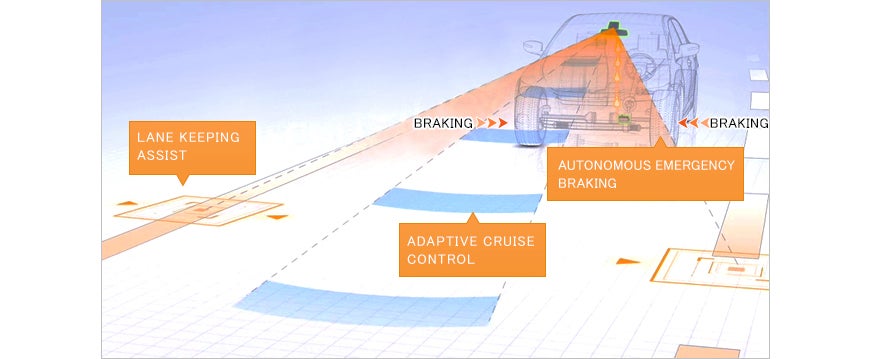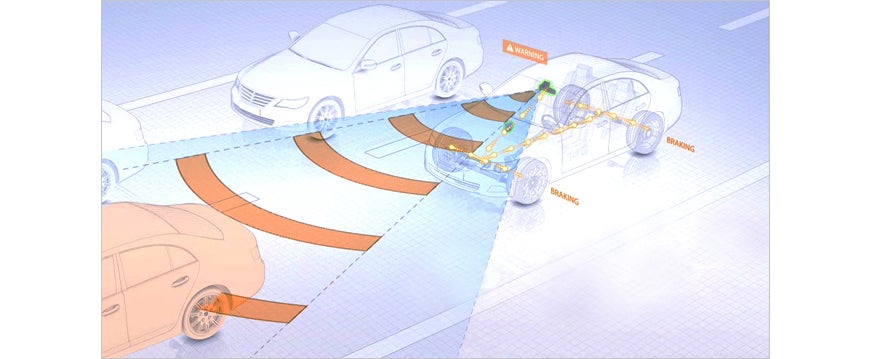Implemented Solutions
Camera & Radar Assisted Driving
Cameras and Radars—Sensors that Play a Central Role in ADAS—
Contributing to Safer Driving
In recent years, a variety of advanced driver assistance systems, designed to make driving safer, have started to make their way into cars. Lane keeping assist, adaptive cruise control, autonomous emergency braking and more—these advanced systems all make use of sensing devices such as millimeter-wave radars, cameras and laser radars. Information gathered by these radars and cameras is used to detect road surface markings, potential obstacles and vehicles ahead on the road among other things. Based on this, other systems can act instead of the driver and perform actions such as letting off the gas—or even braking—if the distance between the car and the preceding vehicle decreases. In this way, ADAS can substitute for human eyes and brains and assist the driver in low-visibility conditions—like mC7C8ist, rain and nighttime darkness—in which accurate detection of obstacles is crucial.

Although sensing devices come in many shapes and forms, Nidec Elesys has chosen to focus on a combination of millimeter wave radars and cameras. When tracking another vehicle in front of the car, the camera is used to find and locate the preceding vehicle, while the millimeter wave radar measures the distance. This information is then used to decide whether it is necessary to slow down or brake. Image recognition software integrated into the camera allows it to detect other vehicles. The millimeter wave radar functions by emitting a FMCW (Frequency-Modulated Continuous Wave) signal around 77 GHz and changing it over time. Transmitting and receiving this millimeter wave signal makes it possible to determine the distance to the preceding car. In contrast with laser-based radars, millimeter wave radars are practically unaffected by rain, snow and fog. The one weakness of millimeter wave radars—susceptibility to objects blocking the hole through which signals pass—is overcome by using a horn antenna to increase sensitivity. Furthermore, our radars are also equipped with detection algorithm software that allows them to distinguish between multiple targets.

In order to utilize the full potential of the various safety-oriented driver assistance systems available, further improvement of the sensing capabilities that they rely on will be necessary. At the same time, the cost of sensing devices is a deciding factor in the spread of driver assistance systems. Although the switch to using SiGe (Silicon-Germanium) for the integrated circuits—instead of the GaAs (Gallium Arsenide) used at first—has already resulted in lower prices, the anticipated arrival of mass-producible silicon CMOS (Complementary Metal-Oxide-Semiconductors) is expected to have a dramatically larger positive effect on prices. At the same time, cameras are on track to even higher resolutions and lower prices. In anticipation of these trends, Nidec Elesys has developed a cost-effective sensor fusion solution integrating the camera and the radar into a single unit. With our cutting-edge technology, we aim to contribute to accelerating the adoption of advanced driver assistance systems.


Developer's Comment
The advent of CMOS integrated circuits will dramatically reduce the cost of millimeter wave radars. Furthermore, inexpensive plastic-lens cameras are on the way as well. As sensing devices become more cost-effective, new functions—such as 360 degree sensing—will become possible and the doors to even more advanced automation systems combining multiple functions will open up. Eventually, this trend is expected to culminate in the arrival of autonomous driving. At the Nidec group, we leverage our many assets—including sensors, motors, control technology and more—to contribute to even more sophisticated advanced driver assistance systems. At the same time, we aim to contribute to the realization of autonomous driving and increased safety and comfort.